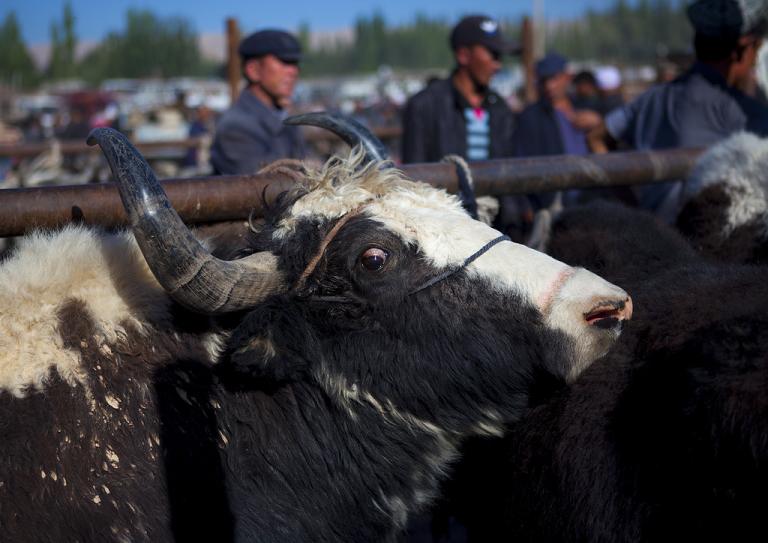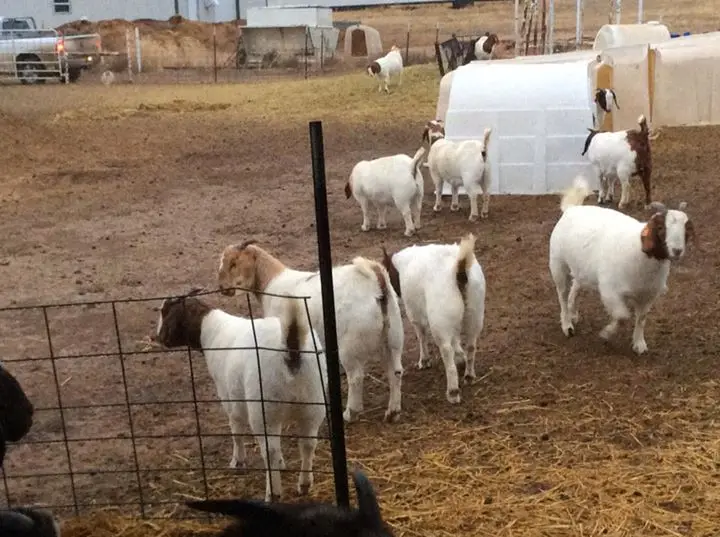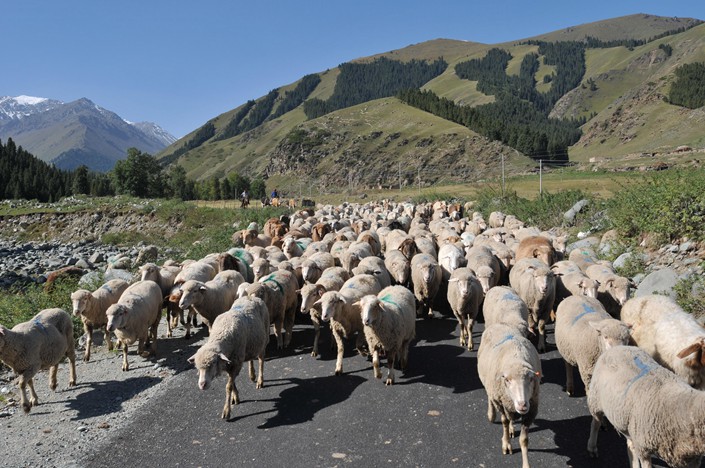Livestock products in Xinjiang
5 min readXin jiang is one of the five ma jor pastoral areas in the country, and the pasture covers 4 ,800 hectares and ranks third behind Inner Mongolia and Tibet in China. Animal husbandryhas been rising rapidly in Xinjiang since 2000, and the productions of livestock product such as beef and mutton, milk, wool and cashmere have been increasing progressively year by year.
Main animal husbandry in Xinjiang is cattle, sheep farming. At present, among the 87 counties(cities) of Xinjiang, there are 22 animal husbandry counties,16 half farming and half animal husbandry counties,49 agricultural counties; among the 1,357,100 people engaged in livestock husbandry,12.6% are rural population; there exist 130 pastures; the grassland area is 51.11 million hectares among which pasture irrigated area is 3.45 million hecatres.

From January to September,2012, the number of livestock on hand in Xinjiang is 50,896,300(of total quantity), an increase of 3.3% over the same period of last year. Among them, the number of cattle on hand is 5,372,000, an increase of 1.4% over the same period of last year; the number of sheep on hand is 40,191,300, an increase of 3.6% over the same period of last year; the number of pigs on hand is 2,420,500, an increase of 4% over the sameperiod of last year. In the same period, the number of livestock on the slaughtered in Xinjiang is 33,118,800(of total quantity), an increase of 4.5% over the same period of last year. Among them, the number of cattle slaughtered is 2,264,500, an increase of 11.6%; the number of sheep slaughtered is 26,824,800, an increase of 4.4%; the number of pigs slaughtered is 4,029,500, an increase of 1.7%. The number of poultry slaughtered is 202 million, an increase of 8.3%. The total meat production volume in Xin jiang is 1,447,900 tons, an increase of 8.8%; milk production volume is 1,927,300 tons, an increase of 7.5%; egg production volume is 295,200 tons, an increase of 10.1%.
Xinjiang is one of the five ma jor pastoral areas in China and is famous for the vast grassland and a large number of livestock. Xin jiang has a long history of animal husbandry.According to archaeological research, as early as 4,000 years ago, there were nomadic tribes living where there is water and grass moved about at the foot of eastern Altai Mountains, Tianshan Mountains and Congling Range and in the north part of the Kunlun Mountains; various tribes settling on plains oases ran agriculture as well as husbandry.Among Uygur, Han, Hui, Kazak, Mongolian, Kirgiz, Ta jik, and Uzbek and other ethnic groupsin Xinjiang, most ethnic minorities have the tradition of running husbandry, breeding livestock, and especially the ethnic groups of Kazakhstan, Mongolia, Kirgiz and Tajik whose main production activity is animal husbandry, are nomadic people in Xin jiang.
Animal husbandry is most widely distributed in grassland and grassland is alsoa forage source with the largest number. Grasslands in Xinjiang mainly include the valleys and step grasslands of Altai Mountains, Tianshan Mountains and the Kunlun Mountains, alluvial plain grasslands and wash plain grasslands of Irtysh River, Bortala River, Ulungur River, li River, Manas River, Kaidu River, Peacock River, Tarim Yarkand River and Hotan River, and the lake grasslands of Wulungu Lake, Aibi Lake, Salim Lake and Bosten Lake.These natural grassland breeds the animal husbandry in Xinjiang. In Xinjiang fine pastures account for 37.5% and middle pastures account for 51.1% of middle pasture. During the 1980s, artificial forage, including artificial grassland, subsidiary agricultural products and industrial feed, has become a very important livestock feed source.
Animal husbandry in Xinjiang has obvious regional characteristics and there are differences in grassland animal husbandry, animal husbandry in agricultural area and animal husbandry in urban suburb. In grassland animal husbandry operated by herdsmen,livestock have to be driven in season pastures at far distance; animal husbandry in agricultural area operated by farmers are mainly scattering drylot feeding and half drylot feeding; animal husbandry in urban suburbs has been close to modern intensive livestock operations. Grassland animal husbandry mainly raises sheep, horses, cattle and camel; animal husbandry in agricultural area mainly raises cattle, sheep, poultry and pigs. Among livestock in Xin jiang, grass-feeding livestock account for more than 97%.

During the long term practices, all ethnic groups in Xinjiang have cultivated many livestock varieties with good production performance and suitable for the local conditions.For example, Altai sheep have large bodies, fat mutton and are cold-resistant, crude feed tolerant and adapt to the grazing; Hotan semi-coarse wool sheep not only can produce much mutton, but also have good tension and elasticity of the wool which is well knownfor weaving rugs out of it; Xinjiang fine wool sheep are promoted by many provinces in China for their long and fine wools, suitable for spinning and also because their mutton and wool can both be utilized. li horses become good horse breed in China for their speed and power. Large and small livestock spread on the large and small natural pastures in the north and south of the Tianshan Mountains, the most are sheep, followed by cattle, horses, goats, donkeys, camels, mules and yaks. Xin jiang’s livestock breeds which are well-known throughout China include Xinjiang fine-wool sheep, Altai large-tailed sheep, Kuqa black lamb, lli horses and Xinjiang Brown cattle, Yangqi horse, Chinese Merino sheep, Xinjiang lli pigs and lli beef and milk cattle. In recent years, various parts of Xinjiang have continuously improved, cultivated and introduced new and quality livestock varieties, some of the indicators have topped in China and livestock production has been developed rapidly; besides to meeting the demand of the autonomous region,a large number of cattle, sheep, horses and donkeys are transported and sold to the interior provinces every year.Developed animal husbandry has provided people with a lot of leather, wool, cashmere, sausage, cream, butter and powdered milk and other animal products. Many cheap and fine animal products and processed products sell well at home and abroad markets.
In the oasis environment of Xinjiang, animal husbandry can protect oases and maintain ecological balance. On the one hand, it can make meat through the ecological transformation of pasture and crop straw; on the other hand, it can compensate the pasture and crop straw by way of returning with organic fertilizer to increase agricultural production volume. In this way, the energy and materials circulation of the oasis system can be facilitated, while the ecological balance is maintained.
Animal husbandry in Xin jiang has distinct ethnic and regional characteristics. In the pastoral and semi-pastoral areas, livestock production is the main economic activity, and the development of animal husbandry affects the improvement of the living standards of the local people as well as other aspects of social development. With the development of animal husbandry, and the processing industry, feed industry, commerce will also develop; modernization of livestock industry in local areas can transform the herdsmen from the nomadic people into settlers or semi-settlers, which will further improvethe local healthcare and education conditions; stable development of animal husbandry will enhance ethnic solidarity and social stability of local areas as well as help consolidate national defense.









